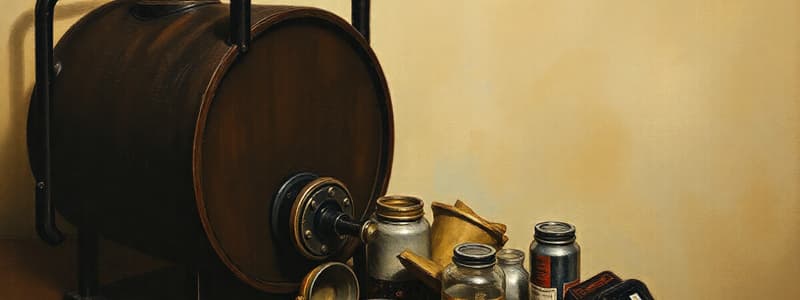Podcast
Questions and Answers
What is the primary purpose of the spillback line associated with C-750 (Regeneration Gas Blower) during the initial process start-up?
What is the primary purpose of the spillback line associated with C-750 (Regeneration Gas Blower) during the initial process start-up?
The spillback line maintains the minimum flow of C-750 during start-up.
Describe the flow path of the two phases separated in D-750 (Regeneration Gas K.O. Drum).
Describe the flow path of the two phases separated in D-750 (Regeneration Gas K.O. Drum).
Liquid bottoms are routed to D-353, while the ethylene vapor overhead is routed to the suction of C-750.
Explain the role of E-760 (Regeneration Gas Heater) in the drier regeneration process, including the heating medium used.
Explain the role of E-760 (Regeneration Gas Heater) in the drier regeneration process, including the heating medium used.
E-760 heats the regeneration gas using Dowtherm to remove moisture from the desiccant in the spent drier.
What is the function of E-750 (Regeneration Gas Cooler) and what utility is used to achieve this function?
What is the function of E-750 (Regeneration Gas Cooler) and what utility is used to achieve this function?
Describe the purpose of the demister pad installed within D-750 (Regeneration Gas K.O. Drum).
Describe the purpose of the demister pad installed within D-750 (Regeneration Gas K.O. Drum).
Flashcards
E-750 (Regen Gas Cooler)
E-750 (Regen Gas Cooler)
Cools and condenses regeneration gas using cooling water.
D-750 (Regen Gas K.O. Drum)
D-750 (Regen Gas K.O. Drum)
Separates liquid from regeneration gas using a demister pad.
C-750 (Regen Gas Blower)
C-750 (Regen Gas Blower)
Compresses ethylene vapor to circulate regeneration gas.
E-760 (Regen Gas Heater)
E-760 (Regen Gas Heater)
Signup and view all the flashcards
Drier Regeneration System
Drier Regeneration System
Signup and view all the flashcards
Study Notes
- When moisture breakthrough occurs in driers D-362A/B, D-384A/B, or D-412A/B, the saturated drier is taken offline for regeneration.
- Regeneration uses a closed-loop system with ethylene pressurized by C-750 (Regeneration Gas Blower).
Regeneration Process
- C-750 sends ethylene to the shell side of E-760 (Regeneration Gas Heater).
- E-760 heats the ethylene using Dowtherm on the tube side.
- A spillback line is used during startup to maintain C-750's minimum flow.
- The hot gas goes to the spent drier to remove moisture from the desiccant.
- The gas returns to the shell side of E-750, where cooling water cools it.
- The cooled gas flows to D-750 (Regeneration Gas K.O. Drum) for phase separation.
- Liquid from D-750 is sent to D-353.
- Ethylene vapor from D-750 is routed back to C-750's suction.
- Excess gas can be routed back to D-360 during the early stages of regeneration.
E-750 (Regeneration Gas Cooler)
- E-750 cools and condenses the gas using cooling water.
- Cooling water runs through the tube side and regen gas flows through the shell side.
- It condenses the gas before it enters D-750.
D-750 (Regeneration Gas K.O. Drum)
- D-750 is 2 feet in diameter and 9 feet long.
- It has a demister pad inside, below the vapor outlet.
- Its purpose is to remove liquid from the gas after cooling.
- Regen gas enters the side, liquid exits the bottom, and ethylene vapor exits the top.
C-750 (Regeneration Gas Blower)
- C-750 is a standard centrifugal blower, powered by a 45 HP electric motor.
- It compresses the ethylene vapor to ensure flow through the regeneration system.
E-760 (Regeneration Gas Heater)
- E-760 heats the gas using Dowtherm.
- Dowtherm runs through the tube side and regen gas flows through the shell side.
- The heated gas is sent to driers D-362A/B, D-384A/B, or D-412A/B.
Studying That Suits You
Use AI to generate personalized quizzes and flashcards to suit your learning preferences.




